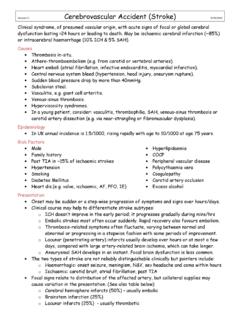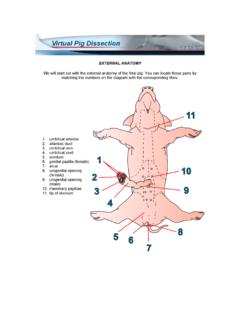Transcription of 286 Thoracic Outlet Syndrome - FRCA
1 Sign up to receive ATOTW weekly - email ATOTW 286 Thoracic Outlet Syndrome , 17/06/2013 Page 1 of 9 This work is licensed under the Creative Commons Attribution-NonCommercial Unported License. To view a copy of this license, visit Thoracic Outlet Syndrome ANAESTHESIA TUTORIAL OF THE WEEK 286 17TH JUNE 2013 Dr Sandeep Kusre, Dr Richard Telford Royal Devon & Exeter Hospital, United Kingdom Correspondence to QUESTIONS Before continuing, try to answer the following questions. The answers can be found at the end of the article, together with an explanation. 1. Which of the following are transmitted through the Thoracic Outlet ? a. Internal jugular vein b. Thoracic duct c. Trachea d. Oesophagus e. Brachial plexus 2. List 5 different causes of Thoracic Outlet Syndrome .
2 3. The following are important anaesthetic considerations in surgical correction of Thoracic Outlet Syndrome . a. Risk of haemorrhage b. Risk of air embolus c. Invasive monitoring with an arterial line is often required d. Post-operative bleeding will be seen by closely monitoring losses into drains e. All patients should have a chest x-ray performed in recovery INTRODUCTION Thoracic Outlet Syndrome (TOS) refers to a constellation of symptoms caused by compression of the neurovascular bundle of the upper limb as they pass between the uppermost rib and clavicle en route to the axilla. Precise symptoms depend on the component affected the brachial plexus, subclavian artery or subclavian vein giving rise to neurogenic, arterial or venous TOS, respective AETIOLOGY Compression of the neurovascular bundle can be caused by congenital or acquired soft tissue and bony abnormalities.
3 (table 1) Any process that narrows the passage through which these important neurovascular structures pass can lead to symptoms of Thoracic Outlet Syndrome . Major locations of compression of the neurovascular structures include over the first rib, behind pectoralis minor and within the scalene muscle triangle. Sign up to receive ATOTW weekly - email ATOTW 286 Thoracic Outlet Syndrome , 17/06/2013 Page 2 of 9 This work is licensed under the Creative Commons Attribution-NonCommercial Unported License. To view a copy of this license, visit Table 1. Causes of Thoracic Outlet Syndrome Skeletal Factors (30%) Soft Tissue Abnormalities Congenital Acquired Cervical rib (figure 1 & 2) Fibrous bands Post- traumatic fibrous scarring Elongated C7 transverse process Variations in scalene muscle insertion Post- operative scarring Exostosis / tumour of 1st rib or clavicle Supernumerary muscles Space- occupying lesion (Pancoast s tumour, cysts)
4 Excess callus following fracture of 1st rib or clavicle Soft tissue inflammation Bifid clavicle Hypertrophic muscles (athletes, swimming) 1st / 2nd rib fusion Poor posture and weak muscular support Figure 1. Chest radiograph showing bilateral cervical ribs Sign up to receive ATOTW weekly - email ATOTW 286 Thoracic Outlet Syndrome , 17/06/2013 Page 3 of 9 This work is licensed under the Creative Commons Attribution-NonCommercial Unported License. To view a copy of this license, visit ` Figure 2. 3D CT reconstruction demonstrating a cervical rib with a small subclavian aneurysm located just distal to the tip of the cervical rib. RELEVANT ANATOMY The relations of the Thoracic Outlet are the body of T1 posteriorly, the medial borders of the first ribs laterally and the superior border of the manubrium anteriorly (figure 3).
5 It transmits the oesophagus, trachea, Thoracic duct, phrenic, vagus and recurrent laryngeal nerves nerves, sympathetic trunks, common carotid and subclavian arteries, internal jugular, brachiocephalic and subclavian veins. The brachial plexus emerges between scalenus anterior and scalenus medius, superior to the Thoracic Outlet , and runs over the first rib into the axilla. It is accompanied by the subclavian artery, which becomes the axillary artery at the lateral border of the first rib. Figure 3. Anatomy of the Thoracic Outlet , demonstrating subclavian artery, vein and brachial plexus passing between the clavicle and first rib roots of brachial plexus subclavian artery subclavian vein internal jugular vein vertebral artery C7 C6 clavicle first rib second rib manubrium sternum Sign up to receive ATOTW weekly - email ATOTW 286 Thoracic Outlet Syndrome , 17/06/2013 Page 4 of 9 This work is licensed under the Creative Commons Attribution-NonCommercial Unported License.
6 To view a copy of this license, visit INCIDENCE TOS most commonly affects young females aged between 20 and 40 years of age, with a 4:1 female to male preponderance. Traumatic causes of Thoracic Outlet Syndrome have an equal sex distribution. CLINICAL PRESENTATION & DIAGNOSIS Neurogenic This refers to compression of the brachial plexus (figure 4), and accounts for the majority of cases of TOS, with symptoms reflecting the nerve roots involved. Symptoms do not follow a dermatomal distribution, distinguishing TOS from radicular nerve pathology. 90% of cases involve the C8 and T1 nerve roots causing pain and paraesthesia in an ulnar nerve distribution and wasting of abductor pollicis brevis, the hypothenar eminence and interosseii.
7 Figure 4. Brachial plexus Involvement of C5, C6 and C7 causes pain referred to the upper chest, neck, ear and outer arm. Radial nerve symptoms can also be present. Symptoms of sympathetic dysfunction, including cold extremities, Raynaud s phenomenon and trophic changes may occur. Nerve conduction studies can play a useful role in helping make the diagnosis, but can be normal. Arterial This is more often seen in patients with a history of arm overuse ( painters, mechanics, swimmers, rowers). Subclavian artery compression causing arterial TOS can lead to pallor, claudication, coldness and paraesthesia. Post-stenotic aneurysm or dilatation, producing a palpable supraclavicular fossa mass, may be seen. Distal embolisation from mural thrombus may cause acute brachial ischemia.
8 Diagnosis is made with a combination of arteriography (figure 5), ultrasound, CT or MRI imaging. musculocutaneous ROOTS TRUNKS DIVISIONS CORDS axillary radial median ulnar long Thoracic nerve C5 C6 C7 C8 T1 Sign up to receive ATOTW weekly - email ATOTW 286 Thoracic Outlet Syndrome , 17/06/2013 Page 5 of 9 This work is licensed under the Creative Commons Attribution-NonCommercial Unported License. To view a copy of this license, visit Figure 5. Arteriography demonstrating subclavian artery aneurysm in a patient with a cervical rib Venous Venous TOS causes swelling and congestion of the arm. Cyanosis, pain in the arm and venous distension over the shoulder and chest may be present. Paraesthesia can occur, and is due to swelling rather than nerve compression.
9 Venous TOS can be thrombotic (Paget-Schrotter Syndrome or effort thrombosis) or non-thrombotic. Thrombotic venous TOS commonly follows strenuous upper body exertion. Repetitive compression of the subclavian vein causes intimal damage, activating the clotting cascade causing acute venous thrombosis. 10% of patients may develop pulmonary emboli. Diagnosis is made by venography (figure 6). Figure 6. Venography demonstrating subclavian vein thrombosis note the meniscus in the subclavian vein Sign up to receive ATOTW weekly - email ATOTW 286 Thoracic Outlet Syndrome , 17/06/2013 Page 6 of 9 This work is licensed under the Creative Commons Attribution-NonCommercial Unported License. To view a copy of this license, visit TREATMENT Management ranges from conservative with advice regarding posture, physiotherapy and multimodal analgesia to surgical intervention.
10 Surgical management can vary from excision of soft tissue or bony abnormalities to complex vascular reconstructions sometimes involving bypass grafts. The transaxillary route is suitable for removal of the first rib in uncomplicated arterial and venous TOS. A cervical rib can also be removed using the transaxillary approach, but the first rib must be removed first in order to gain safe access. The supraclavicular approach is necessary for complicated arterial cases, subclavian aneurysms, and cases of neurogenic TOS which require exploration of the brachial plexus or removal of a cervical rib or band. The first rib can also be removed by the supraclavicular route. Neurogenic Physiotherapy and multimodal analgesic techniques play an important role in the management of neurogenic TOS.















